I Should Have Given It a Name
I recently lost my favorite preparation. It was a metal rod, about three feet long. It was hollow, with a 3 cm perimeter. I thought it was alumi- num, but on trying to replace it, I realized morosely that it wasn’t.
Object Attachment
When I was a kid strolling around our small farm, I always had a strong affection for found objects. Small stones, pieces of driftwood from a small riverbank, special shaped or colored leaves from trees.
Hot pink “Post-it” Notes
I work with a “kit” of sound-making objects that I have been collecting for many years. To play the objects, I activate them physically and ges- turally, and then process their sounds via my Max-based processing instrument.
Palate Whistle
I reinvent principles of vocal articulation distorting and shifting the relationship of mouth, tongue, palate, and breathing patterns. Hid- ing a membrane inside my mouth, an invisible object, yet very noisy, seemed to be an exciting idea.
Sound Objects and Me
Inspired by Hal, I began to make my own instruments (and even be- gan my education as a piano technician), and I eventually discovered the possibilities of the contact microphone, which opens the field of microscopic (microphonic?) discoveries: any object could now bring out a rich and full sound, even for an audience, regardless of how little it sounded acoustically.
Foraging for Streetsweeper Blades (for Magda Mayas)
She promptly gifted me one and after gen- tle but swift inauguration into my arsenal of utensils, these slim metal blades transformed my approach to the semi-acoustic guitar. This initial experience led to a minor obsession with streetsweeper blades and these, new to me utensils, became the basis of a slowly developing group of prepared guitar techniques that I brought into service when performing.
One of My Favorite Things
A favorite object of mine is a small, bugle-shaped bicycle horn that I’ve had since I was 6 years old.
TOGE | MTO — Example 1
Auditory grouping gives rise to events from which perceptual properties are extracted, which then acquire musical functions within a given sonic context
TOGE | MTO — Example 2
Auditory grouping processes and the resulting perceptual qualities and corresponding orchestral effects. [Adapted from Goodchild and McAdams 2021, Fig. 1]
TOGE | MTO — Example 4
Timbral augmentation (sustained, stable): Debussy, La Mer, i, mm. 122–31
TOGE | MTO — Example 5
Timbral augmentation (sustained, transforming): Wagner, Parsifal, Overture, mm. 20–25
TOGE | MTO — Example 6
Timbral augmentation (punctuated): Sibelius, Symphony no. 5, op. 82, iii, mm. 474–482
TOGE | MTO — Example 7
Timbral emergence (sustained, stable): Debussy, La Mer, i, mm. 6–17
TOGE | MTO — Example 8
Timbral emergence (sustained, transforming): Schoenberg, Five Pieces for Orchestra op. 16, iii, mm. 1–11








